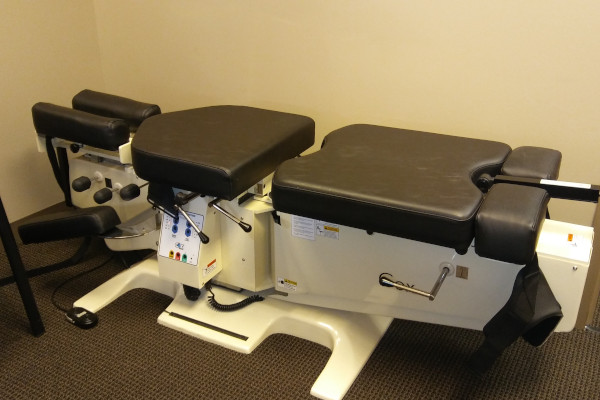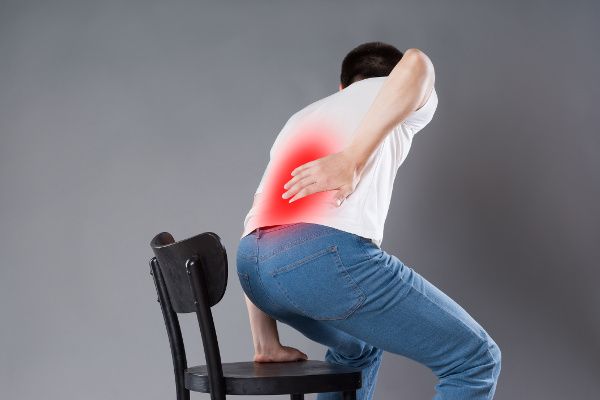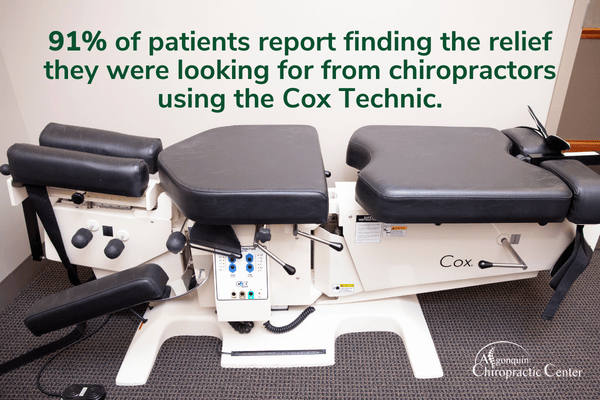Sciatica Treatment in Algonquin
Pain Relief Without Risky Drugs or Surgery
Is sciatica disrupting your life by making it impossible to work, sleep or enjoy hobbies without pain? You may have even had surgery or taken prescription medications, yet the pain remains. We’ve helped countless people in this seemingly hopeless situation find lasting pain relief with our chiropractic approach to sciatica treatment in Algonquin.
What’s our secret? We take the time to identify the root of the problem. Then, we provide the custom treatment plan necessary to help the body naturally heal itself. No risky surgery or addictive medication is necessary!
Ready to find lasting sciatica relief? Call us today to schedule a consultation!
Get to the Root Cause of Your Sciatica Pain
You can’t solve a problem unless you know what’s causing it. This seems logical, doesn’t it? Unfortunately, too often, physicians will provide sciatica treatment that masks the symptoms with potentially addictive medications rather than healing the source of the pain.
Doctors sometimes jump right to injections or surgery when the root cause may have a natural, much less risky option for healing.
Dr. Anthony Galante at Algonquin Chiropractic Center never jumps to such conclusions. He understands that sciatica often originates from a herniated disc and pinched nerve in your spine. He eliminates this pain by gently decompressing and manipulating the bones in your spine back into proper alignment.

Find the Ideal Treatment Option for Your Situation
The best sciatica treatment plan depends on where in your spine the sciatic nerve pain is coming from. Therefore, we’ll perform a thorough examination to pinpoint the cause. This process will include the following steps:
1. Initial Consultation
You will sit down with Dr. Galante to discuss the nature of your pain. By telling him where it hurts, he’ll already have a good idea of the likely source of the problem in your spine. He will also review your medical history to understand your situation fully.
2. Thorough Testing
Next, we will perform non-invasive and painless chiropractic, orthopedic and neurological evaluations to identify the exact cause of your sciatic pain. Then we will consider any necessary imaging, x-rays or MRIs to fully understand your problem.
3. Treatment Recommendation
Based on your test results, we’ll determine whether we can help you or not. Most of the time, we’ll be able to create a sciatica treatment plan for your needs. However, sometimes we won’t be able to help but will always refer you to another physician who can.
Experience Healing with Proven Treatments
Dr. Galante specializes in several sciatica treatment modalities to heal the various spinal problems that can cause the condition. He’ll develop a customized treatment plan for you that features one or more of the following:
- Cox Technic
- Chiropractic Adjustments
- Physical therapy modalities
- Orthotics
- Laser therapy
- Whole body standing vibration
- Spinal bracing
- And more
Dr. Galante is one of the few chiropractors in Illinois certified in the Cox Technic for all three areas of the spine (cervical, thoracic and lumbar). The Cox Technic is a gentle and painless spinal decompression procedure, which is especially effective for taking pressure off the nerve to alleviate sciatica pain.

Get All Your Questions About Sciatica Answered
Dr. Galante doesn’t just treat sciatica. He also helps people understand their sciatica and equips them to promote relief for sciatic nerve pain on their own. He does this by teaching sciatica stretches and exercises you can do to help the healing process. You will also receive helpful tips for living with sciatica, such as how to sleep and sit to avoid pain.
You can learn more about all this by reading Dr. Galante’s Sciatica Survival Guide, which you can download for free below.
Hear From One of Our Sciatica Patients
Get Natural Chiropractic Care for Your Sciatica
Our mission is to get you back to enjoying a pain-free life. Please call today to schedule your sciatica consultation at our office in Algonquin.
Keep Reading to Learn Everything You Need to Know About Sciatica!
At Algonquin Chiropractic Center, one of our priorities is to educate our patients to help them make the best decisions about their health. For this reason, we’ve taken the time to answer all the most crucial questions about sciatica below.
This guide will first teach you what sciatica is, including its causes and symptoms. Then, it will provide some practical exercises, stretches and therapies you can do at home to alleviate sciatic nerve pain. Finally, it will help you make an informed decision about the best type of sciatica treatment to pursue.
We hope this guide serves you well on your journey to a pain-free life. Be well!
Table of Contents
Here is a list of quick links to jump to the different sections in this guide:
- What is Sciatica?
- What Causes Sciatic Nerve Pain?
- What are Sciatica Signs and Symptoms?
- How Does Sciatica Differ from Peripheral Neuropathy?
- What are the Best Exercises for Sciatica Relief?
- What Stretches Should I Do to Ease the Pain?
- What Home Therapies Should I Do for Sciatica Treatment?
- How Should I Position My Body to Help Ease Sciatic Nerve Pain?
- What Professional Treatment for Sciatic Nerve Pain is Available?
- Why Do Chiropractors Provide the Best Sciatica Treatment?
What is Sciatica?
Sciatica describes pain typically felt along the sciatic nerve, which runs from the lower back through the buttock, thigh, lower leg and into the foot.
Sciatica isn’t a disease. Instead, it’s a common set of symptoms. Thus, doctors cannot technically diagnose sciatica. Instead, physicians must determine the underlying problem causing the sciatic nerve pain.
Sciatica most frequently affects people aged 30-50. However, we have also seen it in patients as young as 18 and older than 70.
What Causes Sciatic Nerve Pain?
Since sciatica describes a set of symptoms and not the source of the pain, various underlying causes can lead to this condition. We will discuss a few of the most common causes below.
Disc Herniation/ Slipped Disc
Disc herniation is the most common cause of sciatica. It develops in the lower lumbar spine, where discs between the bony vertebrae act as shock absorbers. When the outer cartilage of those discs wears down, weakens, bulges or tears, herniation can occur. As a result, the inner gel-like fluid breaks through and compresses the sciatic nerve, causing pain, weakness and numbness.
Disc herniation can result from lifting, coughing, bending, falling, motor vehicle accidents or any other trauma. Many patients aren’t sure about the specific cause of their herniation.
Lumbar Degenerative Disc Disease
Lumbar degenerative disc disease develops with age. Over time, discs in the lower back weaken and deteriorate. This decay weakens the structure of the disc and can irritate the nerve root, creating sciatic pain.
Lumbar Spinal Stenosis
Lumbar spinal stenosis happens when the spinal canal narrows and compresses the nerve roots. This narrowing causes pain that’s usually positional, meaning it occurs during some activities and goes away during others. Stenosis most frequently affects people over the age of 60.
Piriformis Syndrome
In most people, the sciatic nerve runs under the piriformis muscle in the buttock. However, in 15% of people, it goes through the muscle instead of under it. As a result, the muscle can shorten due to overuse and compress the sciatic nerve. This compression can also happen if you carry a thick wallet in your back pocket and sit on it often.
Spondylolisthesis
Spondylolisthesis occurs when one vertebra slips forward over the one below it. This misplaced vertebra compresses the spinal nerves and causes pain. Stenosis can develop as a result.
Trauma
External trauma, such as an injury, fall or car accident, can also directly impact the spinal nerves and result in sciatica symptoms.
What are Sciatica Signs and Symptoms?
Sciatica symptoms include pain, burning, sharpness, tingling, weakness and numbness when there are higher pressure levels on the sciatic nerve. You can feel these symptoms anywhere along the sciatic nerve, including the lower back, buttock, leg and foot.
While it’s rare for a sciatica patient to experience pain only in the leg and not in the back, it’s possible and still indicates a problem originating in the back.
When these symptoms are present due to sciatica, they will often vary based on your activity level. Here are some of the situations in which sciatica tends to flare up:
When You Wake Up in the Morning
When you lie down at night, you don’t bear any weight, which removes pressure from the spinal discs. The discs then absorb fluid, which stretches out the already irritated disc fibers and increases your pain.
When You Sit Down
Sitting also increases the pressure on your lumbar discs, causing more pain. Patients with sciatica feel better when they keep moving because prolonged periods of sitting intensify the symptoms.
When You Cough or Sneeze
Coughing and sneezing create spikes in the pressure in your spinal canal, which can push a herniated disc into sensitive nerve fibers. So, if you have sciatica, you should always brace yourself when you feel a cough or sneeze coming.
When You Bend Over
Think of the sciatic nerve as a rubber band running down your back and into your feet. Anything that stretches the rubber band will cause you pain, including bending over.
When You Roll Over in Bed
Movement in bed can increase the pressure on your discs, causing them to push on your sensitive sciatic nerve. Therefore, you may frequently wake up throughout the night.

How Does Sciatica Differ from Peripheral Neuropathy?
The symptoms commonly associated with sciatica can also indicate a different condition called peripheral neuropathy. So, how can you tell if you have sciatica or peripheral neuropathy? The good news is a licensed chiropractor like Dr. Anthony Galante at Algonquin Chiropractic Center can help you answer this question.
Differences By Symptom Placement
Peripheral neuropathy differs from sciatica in that it describes a deterioration of the nerves in the peripheral nervous system, most commonly the nerves in the feet and toes. (This includes all nerves outside the brain and the spinal cord.) Conversely, sciatica refers to irritation and compression of the sciatic nerve in the lower back instead of nerve deterioration.
Because of this, the easiest way to determine which of these conditions you have is to pay attention to when and where the symptoms occur. Sciatica symptoms tend to get worse during activities like sitting for long periods, bending over, lifting or coughing. The symptoms of peripheral neuropathy, on the other hand, tend to stay relatively constant no matter what you’re doing.
Differences In Pain Radiation
The pain from sciatica also tends to radiate from the lower back down through the buttock and the leg. This differs from peripheral neuropathy pain, which usually travels from the hands and feet up through the legs.
Unlike sciatica, peripheral neuropathy also tends to affect both sides of the body, whereas sciatica pain usually only flares on the side where sciatic nerve irritation occurs.
Of course, the best way to determine whether you have sciatica or peripheral neuropathy is to get looked at by a certified chiropractic physician. The doctor will perform the tests necessary to know for sure the root causes of your pain and how to treat them.
What are the Best Exercises for Sciatica Treatment?
When you have sciatica, your first instinct may be to put yourself on bed rest. However, you should resist this urge at all costs! Sitting or lying down for prolonged periods will only intensify the pain and weaken your muscles. Short periods of rest are OK, but you don’t want to be on bed rest for more than 24 hours, and not at all if you can tolerate the pain. Keep walking and moving within your pain tolerance.
For many sciatica and herniated disc patients’ mornings are the worst time of day. Why? At night, when you are not bearing weight, the discs in your spine absorb fluid and swell, which increases pain. You will be a little taller in the morning than at night!
The fastest way to decrease morning pain is to get moving. Weight-bearing will force fluid out of the disc, reducing pressure on sensitive disc fibers. One of the most effective exercises to combat sciatica is the tennis ball exercise. This exercise is especially effective if you’re having pain in your hip or buttock area.
To do the tennis ball exercise, get a tennis ball and lie down on your back. Place the tennis ball under your buttock on the side that hurts. Then, relax and let your body weight compress the muscles. Leave the ball in place for 20-30 seconds before moving it to the next affected area.
Keep in mind that you should perform the tennis ball exercise with caution. Pay attention to how your muscles feel, and if they are especially tender, do the exercise on a bed instead of the floor. Once your muscles strengthen, you can do it on the floor.
What Stretches Should I Do to Ease the Pain?
Along with exercises, there are many gentle stretches you can do for sciatica treatment. Of course, as a rule, if any stretch aggravates your pain, you should stop immediately because it’s a sign you’re irritating the sciatic nerve.
Here are some good stretches you can do to relieve sciatic nerve pain:
Knee-to-Chest Stretch
To do this stretch, lie on your back. Then, interlock your fingers over one knee and pull it gently toward the same shoulder. Hold for 10-30 seconds. Then, do it again, but draw the knee toward the opposite shoulder. Repeat this exercise 2-3 times.
You can watch Dr. Galante demonstrate this stretch in the video below.
Figure-4 Stretch
To do this stretch, lie on your back. Then, cross one leg over the other, placing the outer side of the ankle on the knee. Interlock your fingers under that knee and pull. If done right, you’ll feel an intense stretch in the buttock. Hold for 10-30 seconds and repeat 2-3 times.
You can watch Dr. Galante demonstrate this stretch in the video below.
Cat-Camel Stretch
To do this stretch, get on your hands and knees and arch your back so that you’re looking down at your thighs. Then, arch your back in the other direction so that you’re looking at the ceiling. Do three sets of 15 repetitions once a day.
You can watch Dr. Galante demonstrate this stretch in the video below.
What Home Therapies Should I Do for Sciatica Treatment?
Beyond exercising and stretching, you can also treat your sciatica with home remedies. Here are two effective therapies that we often recommend our patients do at home:
Cold Therapy
An excellent way to alleviate your sciatica is by applying something cold to it. You can use an ice massage, cold pack, ice cubes in a baggie or even a bag of frozen vegetables. The most convenient method is to strap an ice pack around your waist. This way, you can still perform daily activities. If you don’t have a proper strap, you can secure it with an elastic bandage or a towel. Keep it on for 15 minutes, then off for 1-2 hours. Repeat as your schedule allows.
Topical Analgesics
Apply these where it hurts to take the edge off and make your pain more tolerable. Our favorite brand at Algonquin Chiropractic Center is BioFreeze, but you can try over-the-counter brands as well. All topical analgesics work by the same mechanism: stimulating the nerves in your skin so you feel less pain.
How Should I Position My Body to Ease Sciatic Nerve Pain?
There are also precautions you can take to make living with sciatica more tolerable. By strategically positioning your body during daily activities, you will experience much less pain than you would otherwise.
Sleeping Positions
One daily activity that especially requires your attention is sleeping. Whether you sleep on your back or side, you can take steps to protect yourself from pain.
If you sleep on your back, you should place a pillow under your knees. Doing so will gently flex your back, relieving the pressure on your intervertebral discs.
Conversely, if you sleep on your side, bend your knees into a fetal position and place a pillow between your knees and ankles. The pillow will help keep your pelvis correctly aligned to avoid pelvic rotation.
You can also take precautions to avoid pain in the morning. First, you should roll onto your side by the edge of the bed. Then, slowly and carefully slide your legs off the edge and push up with your arms.
Another way to get up is to roll onto your stomach. From there, rotate your body until your legs are off the bed, then push up with your arms.
By positioning your body in these ways, you will make your mornings more tolerable and enjoyable.
Positions for Long Car Rides
People with sciatica are aware of what nightmares long car rides can be. Fortunately, there are things you can do to make your ride go smoother.
First, be careful how you get in and out of the car. To get in, face away from the car seat. Then, slowly and carefully lower your torso and sit down. Next, turn your whole body so you face the front of the car. To get out, perform the same motion in reverse, first rotating in place to face the doorway and then sliding out without bending forward.
If you are going to be driving during a long car ride, you can do many things to make driving more tolerable. First, move your seat forward an inch to flex the knees and lower back. You can also try moving your backrest either further up or further back.
One especially effective method is placing a rolled towel behind your lower back to support the lumbar spine. You can also place a towel 2-3 inches thick under the buttock on the non-painful side to open the spine.
Taken together, these preventative measures should make your long car ride much smoother.
Getting Up from a Seated Position
One final everyday task that requires your attention is getting up from a seated position. To do this, scoot yourself to the edge of your chair and plant your feet firmly below you, staggered. Place your hands on your thighs and then stand straight up. Avoid bending from the waist.
By standing straight up without bending from the waist, you will prevent unwanted wear and tear on your sciatic nerve.

What Professional Sciatica Treatment is Available?
All the home remedies listed above are great, effective tools you can use to control your sciatica pain. However, we’re guessing you don’t just want to learn to live with your sciatica. Instead, you want to overcome sciatica altogether. To achieve this, you will need professional sciatica treatment.
There are many different types of sciatica treatment available to the public. The options are:
- Medical doctors and pain medication
- Pain doctors and epidural steroid injections
- Orthopedic surgeons and spine specialists
- Physical therapists and active exercise
- Doctors of chiropractic and the Cox Technic
We will briefly discuss each option below and then explain why we think the chiropractic option is the best treatment for sciatica.
Medical Doctors and Pain Medication
Medical doctors use medicine to treat sciatica and other forms of back pain. Some of the medications they commonly recommend include over-the-counter painkillers like acetaminophen, muscle relaxants, anti-inflammatories and prescription pain medications.
Included in that last category are dangerously addictive opioids like oxycodone, hydrocodone, Norco, tramadol and methadone. Recently, opioids like these have caused a nationwide epidemic of addictions and overdoses.
There were over 80,000 opioid overdose deaths in 2021, according to the National Institute on Drug Abuse—16,706 of those deaths involved prescription opioids. Moreover, according to the FDA, 59% of people addicted to opioids started taking opioids due to back pain!
Besides the risk of addiction, these drugs are not even the best option for sciatica treatment since the condition is musculoskeletal and not chemical. Yet, many medical doctors prescribe them as their first line of treatment. And although they may cover up your symptoms a bit, they won’t do much to counteract your sciatica in the long term.
Pain Doctors and Epidural Steroid Injections
Your doctor might also send you to a specialist who provides medications and injections for controlling pain and inflammation. However, of patients who receive this sciatica treatment, 50-75% experience short-term relief, but only 25-57% experience long-term relief.
That’s because epidural steroid injections don’t heal the nerve or repair damaged tissue—they just dry up inflammation.
Still, these injections have their place, but it’s not as a first line of defense. Instead, a doctor of chiropractic might use epidural steroid injections as part of their treatment plan.
Orthopedic Surgeons and Spine Specialists
If you go to an orthopedic surgeon or spine specialist, they should spend most of their time suggesting various treatment options and turn to surgery as a last resort.
A 2012 Spine Journal study reported these results for patients who received spine surgery:
- 5% had complications during surgery
- 5% had complications after surgery
- 39% had their stay extended due to complications
- 1% died
Another 2013 study reviewed the cases of 1,885 Washington state injured workers and reported that 42.7% of the workers who consulted a surgeon first had surgery. However, only 1.5% of workers who consulted a chiropractor first had surgery. This disparity reveals that you may get a surgical recommendation from a surgeon even when it is unnecessary. Therefore, we recommend always seeing a chiropractor first!
Yet, for all those risks, patients who receive surgery don’t have substantively better outcomes than conservatively treated patients one or two years later. To be sure, there are specific red flags that may signal a need for surgery. However, for most sciatica patients, surgery is expensive, risky and ultimately not the best route.
Physical Therapists and Active Exercise
Your medical doctor or orthopedic surgeon may recommend physical therapy. However, a 2006 European Spine Journal study showed that patients with leg pain and numbness did significantly better when treated with chiropractic care than with physical therapy. The chiropractic patients showed “significantly lower pain scores” after one year. Other studies have produced similar results for patients with sciatica.
Doctors of Chiropractic and the Cox Technic
The other option is to visit a doctor of chiropractic, who will use a natural treatment for sciatica known as the Cox Technic. This non-surgical, drug-free treatment gently and painlessly stretches the spine to decompress the spinal discs and nerves, relieving pressure and pain.

Why Do Chiropractors Provide the Best Sciatica Treatment?
We think chiropractic care is the best treatment for sciatica for many reasons. First, doctors of chiropractic using the Cox Technic have achieved some of the highest patient satisfaction ratings of any health care provider. Research shows that about 91% of patients report finding the relief they were looking for, and pain ratings decrease from an average of 7.6 to an average of 1.9 after treatment.
Plus, the Agency for Health Care Policy and Research approves of the Cox Technic in their AHCPR Guidelines. They say the Cox Technic is safe and effective, and many high-profile athletes agree, including Joe Montana, Scottie Pippen, Max Scherzer and Jonathon Toews. All of them have used chiropractic care not only to relieve their pain but to boost their performance.
In short, we believe chiropractic care is the right sciatica treatment option for you because it will give you the long-term results you’re looking for.
Are You Suffering from Sciatic Nerve Pain in Algonquin?
We hope this guide has been a helpful resource for helping you understand sciatica. The most important thing we want you to take away from it is you don’t have to deal with sciatica alone, and you do have options! There is plenty of help available, and you can find relief from the pain.
So, if you or a loved one are experiencing symptoms that may be related to sciatica, please don’t hesitate to reach out. We at Algonquin Chiropractic Center have offered sciatica treatment in Algonquin, IL, for over 20 years. Call us today at (847) 854-2000 to schedule an appointment.
For more information on causes and treatment for sciatica, please download our FREE ebook: The Sciatica Survival Guide by Dr. Anthony Galante!
